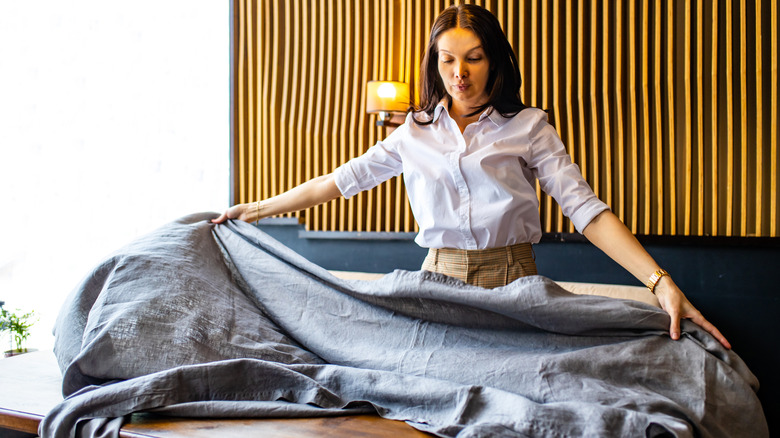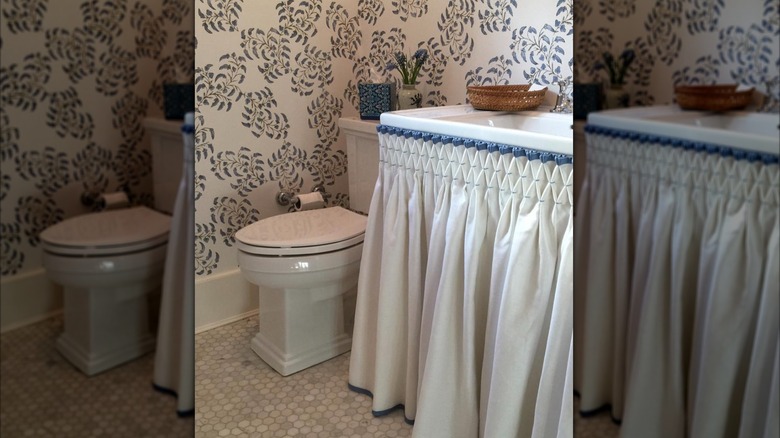The Clever Way To Reuse A Tablecloth In The Bathroom
We may receive a commission on purchases made from links.
Whether you're renovating or redecorating your bathroom, there's one design facet you don't want to overlook: storage. Ample storage space in your bathroom can help hide clutter, manage cosmetics or cleaning supplies, and keep the space organized. However, small bathrooms present a distinct challenge. You simply can't cram a freestanding cabinet or clunky organizer into the corner. Worse, floating shelves or hanging cabinetry is not always the best solution.
Thankfully, even if you're only a little crafty, there is an affordable way to tackle a lack of storage space in your bathroom by reusing a tablecloth. You might be thinking, "Seriously? A tablecloth?" But turning an old or thrifted tablecloth into a sink skirt curtain could be a simple way to save money and find unique patterns or textures that you can't get with traditional sink skirts. Whether you have a floating vanity or a pedestal sink, an attractive sink skirt could give you the hidden storage space you desire while still looking seamless in your design. If you're working on a budget, reusing a tablecloth can help you avoid the hefty costs of lengthy fabric from the store. Additionally, the sink skirt is a trendy option and a no-space-needed way to add personality to your bathroom.
Get creative by repurposing a tablecloth in your bathroom
The sink skirt is a stylish way to utilize under-the-sink storage space in your bathroom, but custom fabrics made for sinks could be pricey. Further, mass-produced curtains don't always suit the height or width of your space. Instead of fretting over traditional sink skirts, consider how you can reuse an old tablecloth, whether thrifted or plucked out of storage.
To transform the tablecloth, start by measuring the space beneath your sink. You'll need to measure the circumference the skirt will cover, as well as the height from where the skirt attaches to the sink down to the floor. Once you have your measurements, cut the fabric to size, leaving some extra space for hemming or creating pleats. Hem your fabric. For a no-sew method, use fabric adhesive, like YHOVID Fabric Glue, to hem. You can also opt to sew in pleats or add elastic for a scrunched look at the top. Next, use double-sided adhesive or hook-and-loop fasteners to attach the fabric to the underside of the sink. Many homeowners prefer VELCRO Tape for Fabrics, which makes the curtain easy to remove and wash. The results are stunning, and you can choose any fabric that suits your space. Just keep in mind that some no-sew materials may have specific instructions about hand washing instead of machine washing.
Tips when DIYing a sink skirt in your home
A sink skirt can create a hidden storage solution that's perfect for adding space to your bathroom without being too clunky or crowded. However, you'll want to ensure you choose the right tablecloth to pull off your design. Square or rectangular tablecloths are the more popular choice to create straight edges when sewing your sink skirt. Circle or oval tablecloths could also be used, but you will need to cut a straight edge on both the top and bottom so that the skirt drapes down to the floor correctly. You could also sew different fabrics together using two tablecloths for a unique tiered look.
When choosing a material for your skirt, aim for a tablecloth that is easy to wash. Machine-washable fabrics and those that can be spot cleaned or wiped down are best. Avoid difficult-to-clean fabrics like velvet, material with sequins, or lace. Further, there's no need to lament if you don't have a pedestal sink. Sink skirts can also be added to cabinet vanities. You may have to get creative and remove cabinet doors or attach a curtain rod to the cabinet during installation. Some homeowners have even opted to hang the skirt directly on the doors. No matter how you choose to style it, you can enjoy the quaint aesthetic of a skirted sink by DIYing your own.

